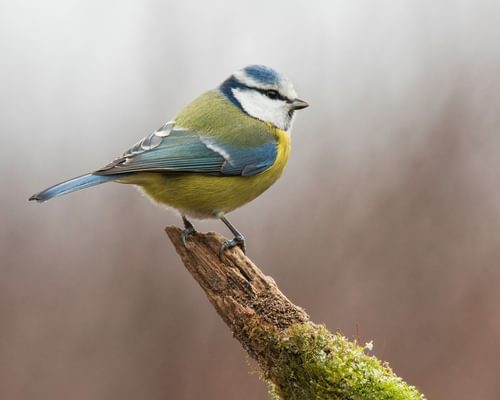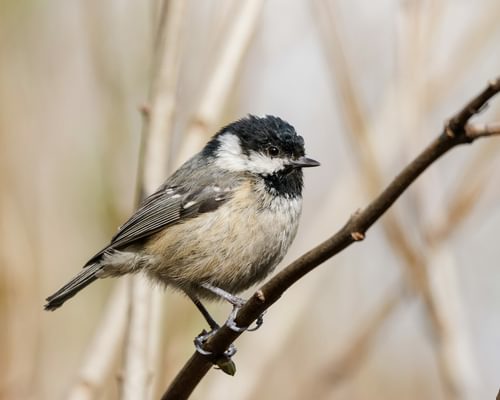Great Tit
Parus major
Visual Identification
Appearance
The Great Tit is a striking small bird with a distinctive black head and white cheeks. Its back is olive-green, wings are blue-grey with a white wing bar, and its underparts are bright yellow with a bold black stripe down the centre.
Males have a wider black belly stripe compared to females. Juveniles are duller with yellowish cheeks. There are no significant seasonal plumage changes in this species.
Size
Length
14cm to 16cm
Wingspan
24cm to 26cm
Weight
14g to 22g
Colours
Males and females have similar plumage
Primary Colour
Yellow Green Blue
Secondary Colour
White Black Olive
Beak Colour
Black
Leg Colour
Grey
Habitat and Distribution
Habitats
Woodland
Garden
Wetland
Coastal
Urban
Farmland
Grassland
Desert
Tundra
Rainforest
Mountain
Savanna
Distribution
Great Tits are widely distributed across Europe, parts of the Middle East, and Asia. They inhabit deciduous and mixed woodlands, parks, gardens, and urban areas with sufficient tree cover.
They are resident year-round and common throughout the UK, adapting well to human-modified landscapes. Their range has been expanding northwards in recent decades, likely due to climate change and increased winter feeding by humans.
Elevation Range
Up to 4,420 meters
Climate zones
Temperate, Subarctic
Distribution Map
This map gives you a rough idea of where you might spot a Great Tit. The coloured areas show countries where these birds have been seen.
A few things to keep in mind:
- Birds might not be everywhere in the coloured areas, for example, they may be present around the coast of that country
- Where birds live can change with seasons and available food
- This map is quite simple - it doesn't show exact locations
We're working on making our maps even better! Soon, we hope to show you:
- More detailed maps for bigger countries, including state and region
- How birds move around during different seasons
Distribution by Region
Behaviour and Ecology
Bird Attributes
This feature is in beta. We'd love your feedback to improve it!
Share your thoughtsBird Attributes Explained
Our bird attributes system rates various aspects of a bird's capabilities on a scale of 0-100, based on data from field observations, scientific studies, and expert knowledge.
Attribute Categories:
- Agility: Manoeuvrability, speed, and grace in flight or movement.
- Strength: Physical power, often correlating with size and hunting abilities.
- Adaptability: Ability to thrive in various environments or changing conditions.
- Aggressiveness: Territorial behaviour and assertiveness, particularly during breeding seasons.
- Endurance: Stamina, often seen in migration patterns or foraging behaviours.
Understanding the Ratings:
- 0-20: Very Low
- 21-40: Low
- 41-60: Average
- 61-80: High
- 81-100: Very High
Remember, these attributes are relative to other bird species and don't necessarily indicate superiority.
Hover over the icon next to each attribute for more information.
Tap the icon next to each attribute for more information.
Agility
Reflects the bird's manoeuvrability, speed, and grace in flight or movement.
Great Tits are highly agile birds, known for their acrobatic foraging behaviour. They're often seen hanging upside down from branches and can manoeuvre swiftly through trees and shrubs, demonstrating excellent aerial dexterity.
Strength
Indicates the bird's physical power, often correlating with size and hunting abilities.
While not particularly strong for their size, Great Tits possess adequate strength for their lifestyle. They can crack open seeds and nuts, and their ability to use tools like pine needles suggests some degree of physical capability.
Adaptability
Represents the bird's ability to thrive in various environments or changing conditions.
Great Tits show remarkable adaptability. They thrive in various habitats from woodlands to urban areas, adjust their diet seasonally, and demonstrate problem-solving skills. Their ability to learn new behaviours, such as opening milk bottles, further highlights their adaptability.
Aggressiveness
Measures the bird's territorial behaviour and assertiveness, particularly during breeding seasons.
Great Tits are relatively bold and can be aggressive in defending their territories and nests. They establish social hierarchies, which involves some aggressive displays. However, they're not considered overly aggressive compared to many other bird species.
Endurance
Reflects the bird's stamina, often seen in migration patterns or foraging behaviours.
Great Tits demonstrate good endurance, particularly during the breeding season when they continuously forage to feed their chicks. Their ability to survive harsh winters in temperate and subarctic climates also suggests a fair level of endurance.
Diet
Great Tits have a varied diet, primarily consisting of insects, spiders, and seeds.
In spring and summer, they feed heavily on caterpillars and other invertebrates. During winter, they switch to more fruit, berries and seed-based diets, readily visiting bird feeders for sunflower seeds and peanuts.
Behaviour
Great Tits are bold and acrobatic foragers, often seen hanging upside down from branches to reach food. They are highly adaptable and curious, and they are known for their problem-solving abilities in accessing food sources. In social settings, they establish and maintain hierarchies through vocalisations and displays.
Vocalisation
Great Tits are known for their varied and complex vocalisations. Their most recognisable call is a clear, two-syllable 'teacher-teacher' or 'tee-cher tee-cher'. They also produce a scolding 'chur-chur-chur' when alarmed.
Males have a repertoire of over 40 different songs used in territorial defence and mate attraction.
Nesting & Breeding
Great Tits typically form monogamous pairs during the breeding season, which begins in early spring. Males attract females with song and courtship feeding.
Nests are built in tree cavities, nest boxes, or even unusual places like letter boxes. The female constructs the nest using moss, grass, and animal hair. She lays 5-12 white eggs with reddish-brown spots.
Incubation lasts about 13-15 days, performed solely by the female. Both parents feed the chicks, which fledge after 18-21 days. Great Tits often produce two broods per season in favourable conditions.
Conservation and Status
Global Conservation Status
While the Great Tit is currently listed as Least Concern, it faces challenges from habitat loss and climate change. Conservation efforts focus on maintaining suitable woodland habitats and providing nesting boxes in urban areas. Citizen science projects play a crucial role in monitoring population trends.
Birdwatching Tips
- Look for Great Tits in gardens, parks, and woodlands
- Listen for their distinctive 'teacher-teacher' call
- Observe feeders, as they readily visit bird tables and nut feeders
- Watch for their acrobatic foraging behaviour in trees
- In the UK, participate in the RSPB's Big Garden Birdwatch to contribute to population monitoring
Additional Information
Quick Facts
Predators
Main predators include sparrowhawks, domestic cats, and small mammals like weasels and squirrels. Nest predators such as woodpeckers and snakes also pose a threat to eggs and chicks.
Did You Know?
- Great Tits can learn to recognise and avoid toxic prey by observing other birds.
- They have been observed using tools like pine needles to extract larvae from bark.
- In some urban areas, Great Tits have learned to open milk bottle tops to drink the cream.
FAQs
How to attract Great Tits?
Great Tits are one of the UK’s most abundant garden birds and are easily attracted to food, shelter, and water. These birds frequent bird feeders, where they enjoy suet, sunflower seeds, and peanuts. They will happily feed from hanging feeders, bird tables, or even from the ground.
Installing a nest box in your garden is a fantastic way to attract these birds, and they may even use it for roosting in the non-breeding season. A nest box with a 28-millimetre entrance hole placed one to five meters above the ground is ideal for these lovely birds.
They also enjoy visiting water sources where they can drink and bathe. The ideal birdbath for Great Tits is an inch or so deep, but a sloping design that reaches four inches (10 cm) will attract many other bird species.
Remember to clean your birdbaths and feeders regularly to maintain hygienic conditions for our feathered friends.
Similar Birds
References
- 1 2
website: BirdLife International. 2016. Parus major. The IUCN Red List of Threatened Species 2016: e.T22735990A87431138.
View source - 3
report, 2007: del Hoyo et al.
Share Your Feedback
We value your opinion! Let us know what you think about this bird page.

